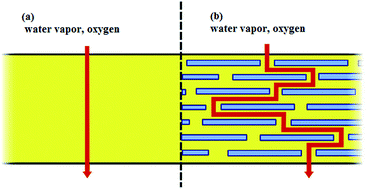Formation and oxygen diffusion barrier properties of fish gelatin/natural sodium montmorillonite clay self-assembled multilayers onto the biopolyester surface
Abstract
In order to expand the application of bio-derived polymers it is imperative that the issues related to their poor gas barrier properties be addressed. Here we explore the sequential layer by layer electrostatic self-assembly approach (abbrev. LbL) for modifying the oxygen transmission rate (OTR) of biopolyesters with the trademark – FF 1482® (abbrev. BP) by deposition of fish gelatin/natural montmorillonite clay (trademark – Cloisite Na+, abbrev. CloNa+). We will show that the deposition of fish gelatin/CloNa+ onto the BP surface is influenced by different process parameters such as dipping time, drying step, polyelectrolyte concentration and surface activation of the BP film via partial alkaline hydrolysis as well as via low pressure plasma. Micro-attenuated total reflectance Fourier-transform infrared spectroscopy (mATR-FTIR) and scanning electron microscopy/energy dispersive spectroscopy (SEM/EDS) showed that the traditional dipping LbL technique, which involves keeping the film wet throughout all deposition cycles, led to a heterogeneous multilayered structure. The addition of the drying step has proven to be a crucial parameter to obtain a quite homogenous fish gelatin/CloNa+ multi-layered structure. Further, the homogeneity of the multi-layered structure was considerable improved when both the CloNa+ concentration was increased and the BP film surface was activated. By exploiting these processing parameters we were able to achieve successful homogenous fish gelatin/CloNa+ multi-layered structures as shown by SEM/EDS analysis. Further, the optimised samples showed a drastic decrease in OTR. For example, the OTR value for the sample, in which the BP surface was activated via plasma treatment prior to deposition of fish gelatin/CloNa+, was reduced by 97% of the corresponding value of untreated BP film. This remarkable barrier may be attributed to a greater dispersion of the impermeable inorganic CloNa+ platelets which forces the oxygen molecules to diffuse around them rather than take a straight line pathway that lies perpendicular to the film surface. Thus, this results is a long and tortuous pathway for oxygen molecule diffusion through the multilayered structures.


 Please wait while we load your content...
Please wait while we load your content...